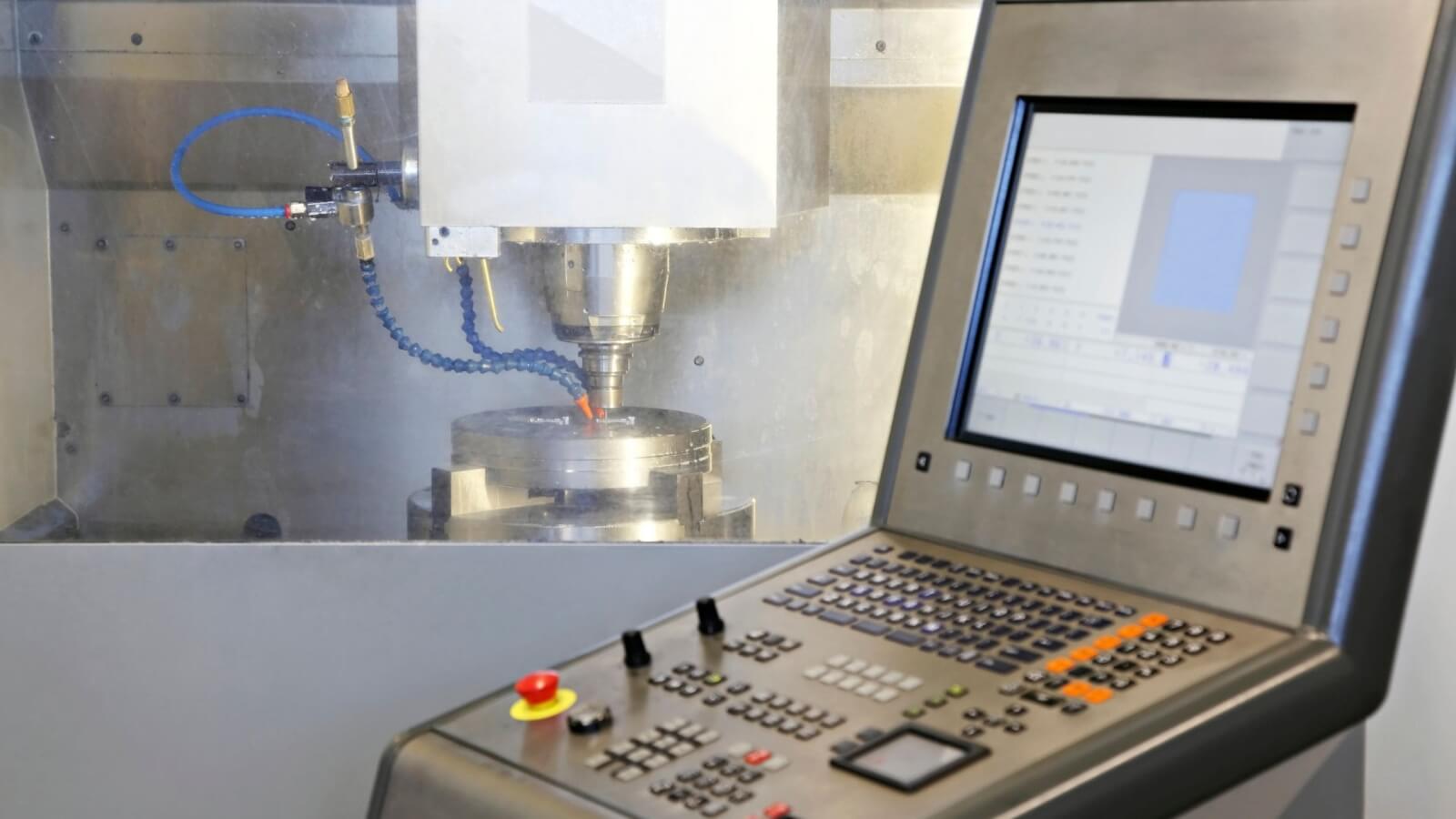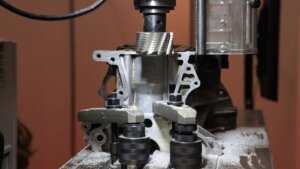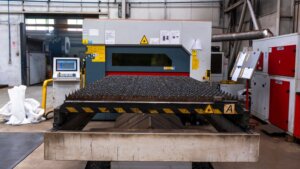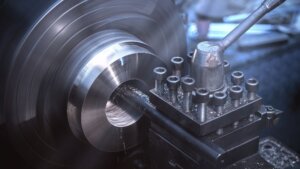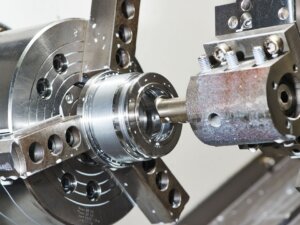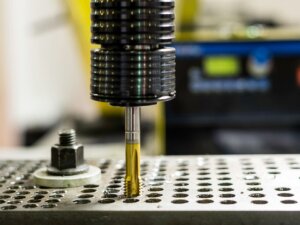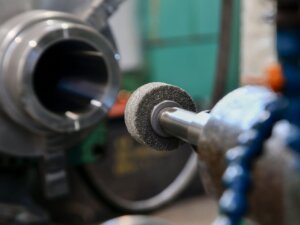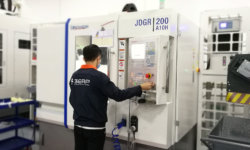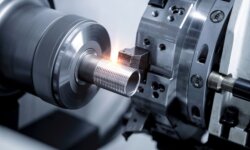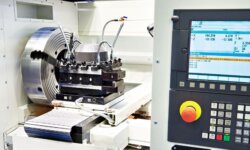CNC machining has revolutionized the manufacturing industry, making the production of precise and complex parts easier. Fortunately, there’s still more to come, and that’s what we hope to explore in this article.
Understanding the future of CNC machining is crucial as advancements like automation and robotics are reshaping the industry, driving efficiency and innovation in manufacturing operations.
What is the Current State of CNC Machining?
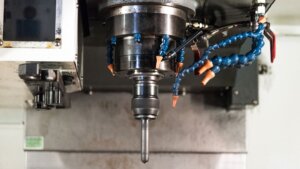
The current landscape of CNC machining is marked by the widespread adoption of advanced technologies and materials. CNC machines have become integral to various manufacturing processes, offering unparalleled precision and efficiency. Modern CNC systems are capable of handling a wide range of materials, from metals to composites, enabling the production of intricate components with high accuracy. The use of resource management software and production control systems has further enhanced the capabilities of CNC machining, allowing manufacturers to optimize their operations and reduce waste.
In the CNC machining industry, the integration of Industry 4.0 technologies is becoming increasingly common. These technologies, including the Internet of Things (IoT) and data analytics, are enabling smarter, more connected production environments. Manufacturers are leveraging these advancements to improve product quality, increase production resilience, and adapt to evolving customer demands.
How is the CNC Machining Industry Evolving?
The CNC machining industry is undergoing significant transformations driven by technological advancements and market demands. As we move further into the era of Industry 4.0, CNC machines are becoming more integrated with automation systems and artificial intelligence, leading to smarter, more efficient manufacturing processes. The future of CNC machining is shaped by the growing use of robotics, the increasing need for precision in production, and the continuous development of new materials and methods.
Market Growth
The global CNC machining market is experiencing substantial growth, supported by various legislative measures and technological advancements. In 2024, initiatives such as the IIJA, CHIPS and Science Act, and the Inflation Reduction Act have spurred significant investments in infrastructure and technology, bolstering the CNC machining industry’s outlook. Despite challenges like economic uncertainty, skilled labor shortages, and supply chain disruptions, the industry continues to thrive. The integration of smart factory solutions and advanced technologies like AI and IoT is helping manufacturers improve efficiency and reduce costs, making CNC machining more resilient and adaptable.
Projections indicate that the CNC machine market is expected to reach $129 billion by 2026, driven by increased demand in sectors such as automotive, defense, medical, and aviation. Key strategies being adopted include the integration of Computer-Aided Manufacturing (CAM) and Computer-Aided Design (CAD) systems, which enhance precision and streamline manufacturing processes. Additionally, reshoring production to the U.S. is becoming more prevalent as companies seek to mitigate logistical challenges and improve market responsiveness.
Resourcing
The CNC machining industry is undergoing significant changes in global resourcing strategies, with a marked shift towards localized supply chains and reshoring to the United States. This trend is largely motivated by the need for greater control over manufacturing processes and supply chains, especially in light of recent global disruptions such as the pandemic and geopolitical tensions. By moving production closer to home, U.S. manufacturers are better positioned to mitigate risks associated with overseas production, such as delays, high shipping costs, and communication barriers.
The stabilization of the U.S. market has made it an attractive option for CNC machining operations, offering competitive lead times and pricing. Technological advancements in production processes and more efficient logistics have further enhanced the agility of domestic production. As the global CNC machining market is projected to reach $128.86 billion by 2026, driven by the need to lower operating costs and integrate advanced technologies, the strategic importance of reshoring continues to grow. This shift not only reduces costs and improves market responsiveness but also creates local jobs, aligning with broader industrial trends toward more autonomous and connected manufacturing environments.
Technological Advancements
Recent technological developments are significantly shaping the future of CNC machining. The integration of Industry 4.0 technologies, such as the Internet of Things (IoT), data analytics, and artificial intelligence (AI), is transforming traditional manufacturing processes. These advancements enable CNC machines to operate with greater precision, efficiency, and autonomy. For example, IoT allows machines to communicate with each other and with centralized systems, providing real-time data that can be used to optimize production workflows and reduce downtime.
The adoption of additive manufacturing, or 3D printing, is also revolutionizing the CNC machining industry. By combining CNC machining with additive manufacturing, manufacturers can create complex parts with high precision and minimal waste. This integration not only enhances product quality but also speeds up the product development cycle, enabling faster time-to-market for new products. Additionally, advancements in material science are expanding the range of materials that can be used in CNC machining, from traditional metals to advanced composites and ceramics.
What Are the Main Trends Shaping the Future of CNC Machining?
The future of CNC machining is being shaped by several key trends that are transforming the manufacturing industry. Among these, automation and robotics stand out as critical factors driving the evolution of CNC machining processes. As the industry embraces Industry 4.0, the integration of advanced technologies like the Internet of Things (IoT), big data analytics, and AI is becoming more prevalent. These innovations are enhancing the efficiency, precision, and flexibility of CNC machines, allowing manufacturers to meet increasing demands for high-quality products while addressing challenges such as labor shortages and rising production costs.
Automation and Robotics
Automation and robotics are playing an increasingly important role in the future of CNC machining, fundamentally altering how manufacturing operations are conducted. The growing integration of automation in CNC machining is driven by the need to streamline complex processes that involve multiple machines and operations. By incorporating Industry 4.0 technologies, such as IoT and big data analytics, CNC machines can now communicate with each other and with central control systems in real time. This connectivity allows for seamless coordination across various stages of production, significantly reducing the risk of errors and defects.
One of the key benefits of automation in CNC machining is the ability to optimize production processes. For instance, IoT technologies enable machines to monitor their own performance and automatically alert maintenance staff when servicing or tool replacement is needed. This proactive approach enhances machine uptime and reliability, leading to increased production speed and efficiency. Additionally, big data analytics plays a crucial role in analyzing the vast amounts of data generated during CNC operations. By identifying patterns and trends, manufacturers can make informed decisions to further optimize their processes, reducing waste and improving product quality.
Artificial Intelligence and Machine Learning
Artificial Intelligence (AI) and Machine Learning (ML) are revolutionizing CNC machining by enhancing various aspects of the manufacturing process. One of the primary applications of AI in CNC machining is predictive maintenance, which allows manufacturers to monitor machine performance in real-time. By analyzing data streams from CNC machines, AI systems can predict when maintenance is needed, preventing unexpected downtime and reducing maintenance costs. This capability not only improves machine reliability but also extends the lifespan of equipment, making operations more cost-effective.
AI and ML are also instrumental in process optimization. By leveraging vast amounts of data, AI can identify patterns and trends that are not immediately obvious to human operators. This analysis helps in fine-tuning machining processes to achieve higher precision and efficiency. For instance, AI can adjust feed rates, cutting speeds, and tool paths in real-time to optimize production based on the specific characteristics of the material being machined. This level of process control ensures that the final product meets the highest standards of quality, while also minimizing material wastage and energy consumption.
In terms of quality control, AI plays a crucial role by enabling real-time monitoring and inspection of parts during the machining process. Advanced AI algorithms can detect defects or deviations from the desired specifications early in the production cycle, allowing for immediate corrective actions. This reduces the likelihood of producing defective parts, thereby improving overall product quality and reducing scrap rates. The integration of AI with CNC machines is also paving the way for the development of smart factories, where machines can autonomously adjust their operations based on real-time data, leading to more flexible and responsive manufacturing processes.
Industry 4.0 and Smart Manufacturing
The integration of Industry 4.0 technologies is redefining CNC machining, bringing about a new era of smart manufacturing. At the core of this transformation is the adoption of the Internet of Things (IoT), which connects CNC machines to a network of devices and systems. This connectivity allows for real-time data sharing and communication between machines, leading to enhanced production control and efficiency. IoT enables manufacturers to monitor every aspect of the machining process, from material usage to machine performance, ensuring optimal resource utilization and reducing operational costs.
Smart manufacturing technologies are also addressing critical challenges in the manufacturing industry, such as labor shortages and supply chain disruptions. By automating routine tasks and providing real-time insights into production processes, these technologies help manufacturers maintain competitiveness in a rapidly changing market. For instance, the use of data analytics and cloud computing allows for comprehensive visibility into production operations, enabling manufacturers to quickly adapt to changes in demand or supply chain constraints.
More Sophisticated Machines with Additive Manufacturing Integration
The future of CNC machining is being significantly influenced by the integration of more sophisticated machines, particularly those combining traditional CNC capabilities with additive manufacturing. This trend is driven by the increasing demand for complex, high-precision parts that can be produced quickly and efficiently. Manufacturers and job shops are heavily investing in advanced CNC machines, such as 5-axis models, which excel in handling intricate geometries and reducing production time. These machines enable “done-in-one” processes, allowing entire manufacturing sequences to be completed on a single machine. This efficiency aligns with the broader industry goal of achieving lights-out manufacturing, where operations can continue autonomously, reducing the need for constant human oversight.
A key development in this area is the integration of additive manufacturing, or 3D printing, with CNC machining. This hybrid approach combines the strengths of both technologies, offering unprecedented flexibility and capability in production. For example, manufacturers can now print complex structures and then finish them with CNC machining, ensuring high precision and optimal surface quality. Tools like Xebec’s automated deburring brushes, made from continuous ceramic fiber, are becoming essential in these environments, enhancing the efficiency and cost-effectiveness of finishing operations.
Machine Cost
The trend towards more sophisticated CNC machines is accompanied by varying costs, influenced by the integration of advanced technologies. While basic CNC machines are becoming more affordable, making advanced machining capabilities accessible to a broader range of manufacturers, high-end machines remain expensive due to the incorporation of cutting-edge features like automation, advanced sensors, and artificial intelligence. These technologies increase the initial costs of CNC machines by approximately 30%, but they also significantly enhance the machines’ capabilities.
The investment in these advanced machines is justified by the long-term savings they offer. By improving production speed, maximizing precision, and reducing waste and energy consumption, these machines lead to a 50% increase in operational efficiency.
Micromachining and Precision Engineering
The demand for high precision in CNC machining is increasing, particularly in industries like aerospace, defense, and medical devices, where even minor discrepancies can lead to significant issues. Micromachining, which involves the production of small and intricate parts with exceptionally tight tolerances, is becoming more prevalent as manufacturers strive to meet these stringent requirements. Recent advancements in CNC machines have pushed the boundaries of what is possible in terms of accuracy and precision.
Modern CNC machines equipped with advanced sensors and control systems can maintain tolerances within a few micrometers, ensuring that parts are produced with exceptional accuracy. This level of precision is essential in producing components that must meet rigorous standards. Additionally, tools like diamond-tipped cutting instruments are now being used to achieve superior surface finishes and machining accuracy, especially when working with tough materials like stainless steel or titanium. The development of advanced cutting fluids and coolants has further refined the machining process by reducing thermal influence and tool wear, which improves the quality of the final product.
Sustainability and Green Manufacturing
Sustainability is becoming a central focus in the CNC machining industry, driven by both technological advancements and a growing commitment to environmental responsibility. In 2024, CNC machining is making significant strides towards reducing its carbon footprint, particularly through the integration of energy-efficient technologies and processes. The adoption of AI and IoT in smart factories is playing a crucial role in this shift, enhancing production efficiency and reducing waste by optimizing manufacturing processes in real time.
One of the key areas of improvement is the move towards sustainable materials. Manufacturers are increasingly using biodegradable plastics, recycled metal alloys, and natural fiber composites to maintain product quality while minimizing environmental impact. These materials not only help reduce waste but also align with the broader industry goals of sustainability and resource efficiency. Additionally, on-demand manufacturing and Just-In-Time (JIT) production are becoming more common, optimizing energy use by producing goods only when needed, thus reducing excess production and associated waste.
What are the Future Technologies in CNC Machining?
As CNC machining continues to advance, several future technologies are shaping the industry, enhancing both efficiency and precision. These advancements are critical as the manufacturing industry demands higher accuracy, quicker production times, and more sustainable practices. Below, we will explore three key technologies that are transforming CNC machining.
Virtual and Augmented Reality
Virtual and augmented reality (VR/AR) are increasingly being used in CNC machining for training, simulation, and design. These technologies create immersive environments where operators can interact with CNC machines in a risk-free setting. By using VR/AR, you can practice and perfect complex machining processes without the consequences of errors, making the learning curve shorter and safer. Additionally, VR/AR enables designers to create and test detailed 3D models before any physical materials are used. This approach allows for the identification and correction of potential design flaws early, which saves time and reduces costs in the prototyping phase. Despite the benefits, the adoption of VR/AR requires a significant investment in specialized hardware and software, as well as additional training for operators. However, the advantages, including improved safety, enhanced design accuracy, and streamlined training, make VR/AR a valuable tool in the future of CNC machining.
Remote Monitoring and Control
The future of CNC machining will see a significant shift towards remote monitoring and control, driven by advancements in IoT and data analytics. Remote monitoring allows you to oversee CNC machines from anywhere, using real-time data to track performance and detect issues before they lead to downtime. This capability is especially beneficial for predictive maintenance, where data analytics can predict when a machine is likely to fail, allowing for proactive repairs that minimize disruptions to production. By reducing unplanned downtime and extending the lifespan of CNC machines, remote monitoring and control are crucial for maintaining efficiency in modern manufacturing environments. This technology also supports the broader trend of smart manufacturing, where interconnected systems and real-time data enable more responsive and efficient production processes.
New Methods in Material Testing
Material testing in CNC machining is evolving, particularly with the need for creating precise test specimens required for tensile testing. These tests are vital in industries such as aerospace and automotive, where material properties must meet strict standards. CNC machining enables the production of test specimens with exacting dimensions, such as flat (dog bone) and round shapes, which are essential for reliable testing outcomes.
Flat tensile specimens, common in sectors like aerospace, are often produced using CNC milling machines or laser cutters. CNC milling is particularly effective for hard materials, while laser cutting minimizes material stress, reducing potential deformation that could affect test results. For round specimens, CNC lathes provide the uniform cylindrical shapes necessary for consistent testing.
What Challenges and Considerations Lie Ahead for The Future of CNC Machining?
The future of CNC machining faces significant challenges, including increasing complexity, rising costs, and evolving technology requirements. As the manufacturing industry continues to advance, managing the growing intricacy of CNC processes, controlling the costs associated with adopting new technologies, and maintaining high standards of quality become crucial. These challenges demand strategic planning and innovative solutions to ensure the CNC machining industry remains competitive and efficient.
Complexity Management
As CNC machining processes become more sophisticated, managing this complexity is a critical concern. The integration of advanced technologies such as Industry 4.0, additive manufacturing, and automation systems has introduced new layers of intricacy in manufacturing operations. To effectively manage this, manufacturers are increasingly relying on advanced resource management software and production control systems. These tools enable real-time monitoring and optimization of machining processes, ensuring that each step is executed with precision and efficiency.
Moreover, the complexity of CNC machining is further heightened by the need to produce diverse product variants and customized parts. This requires flexible machining processes that can adapt to different materials, geometries, and production demands. The ability to efficiently handle this complexity is vital for maintaining production resilience and delivering high-quality products.
Cost Considerations
The adoption of new technologies in CNC machining brings significant cost implications. While advancements in CNC machines, such as the integration of IoT, automation, and data analytics, promise increased efficiency and production speed, they also come with higher upfront costs. For instance, the latest CNC machines equipped with advanced sensors and automation systems can be about 30% more expensive than traditional models. However, these technologies also offer long-term benefits, such as reduced energy consumption, lower material wastage, and enhanced production control, which contribute to overall cost savings.
Skilled Labor Shortage
The CNC machining industry is facing a significant challenge due to an impending shortage of skilled labor. As a large portion of the current workforce approaches retirement, the demand for experienced CNC operators and technicians is growing. The transition of manufacturing into a high-tech sector, driven by Industry 4.0, increases the need for workers proficient in advanced technologies, such as automation systems and resource management software. To address this, educational programs are increasingly focused on introducing students to CNC machining and related fields, while companies are implementing mentorship programs to transfer knowledge from experienced workers to newer employees. Additionally, the automation of routine tasks allows workers to focus on more complex and rewarding activities, which can help attract and retain talent.
Cybersecurity Risks
As CNC machines become more interconnected and integrated with advanced technologies like IoT and data analytics, cybersecurity risks have emerged as a critical concern. The increased connectivity of CNC systems, while enhancing production efficiency and real-time monitoring, also opens up vulnerabilities to cyber threats. Unauthorized access to these systems can lead to data breaches, operational disruptions, and even physical damage to equipment. To mitigate these risks, manufacturers must invest in robust cybersecurity measures, including encryption, regular software updates, and secure network architectures. Additionally, employee training on recognizing and responding to potential cyber threats is crucial.
How The Future Innovations in CNC Machining Will Impact Various Industries
Future innovations in CNC machining will significantly influence industries such as aerospace, defense, and automotive manufacturing. These advancements are set to enhance precision, efficiency, and adaptability, allowing industries to meet evolving demands and overcome current limitations.
Aerospace and Defense
In the aerospace and defense sectors, CNC machining will play a critical role in maintaining and advancing the high standards of precision and reliability required. As the industry increasingly adopts lightweight and high-strength materials like titanium and carbon fiber, CNC machines are evolving to handle these materials with greater accuracy. This precision is crucial in producing components that must withstand extreme conditions, such as high temperatures and stress in aerospace applications. Additionally, the integration of additive manufacturing with CNC machining offers the aerospace industry new possibilities in design and prototyping, enabling the creation of complex geometries that were previously unattainable.
Automotive Industry
The automotive industry is another area where CNC machining is set to make a substantial impact. As the industry moves towards electric vehicles (EVs) and autonomous driving technologies, the need for precise and efficient manufacturing processes is more critical than ever. Innovations in CNC machining, such as advanced automation systems and real-time data analytics, are helping manufacturers streamline production processes, reduce costs, and increase production speed. The ability to produce lightweight components with high precision is particularly important in the automotive industry’s quest for improved fuel efficiency and performance. Additionally, the integration of CNC machining with Industry 4.0 technologies, such as the Internet of Things (IoT) and smart manufacturing systems, allows for more flexible and responsive production lines that can quickly adapt to changing demands and new product variants.
Medical Devices
In the medical devices industry, CNC machining will play an increasingly vital role in the production of precision instruments and implants. The need for exacting standards in this field cannot be overstated, as even minor deviations can have significant implications for patient safety and device effectiveness. CNC machines, with their ability to produce intricate parts with tight tolerances, are well-suited for manufacturing components such as surgical tools, orthopedic implants, and dental devices. Furthermore, the integration of additive manufacturing with CNC processes allows for the creation of customized implants tailored to individual patient needs. This combination enhances the precision and personalization of medical devices, improving patient outcomes.
Consumer Electronics
The consumer electronics industry relies heavily on CNC machining for the production of high-precision components that are integral to devices like smartphones, laptops, and wearables. As devices become more compact and feature-rich, the demand for precision manufacturing continues to grow. CNC machines are capable of producing components with the intricate geometries and fine details required for modern electronics. The future of CNC machining in this industry will likely see further integration with automation and Industry 4.0 technologies, allowing for faster production times and greater flexibility in design. Additionally, the use of advanced materials, such as lightweight metals and composites, will be facilitated by CNC processes, enabling manufacturers to create durable, yet lightweight products.
What Are the Innovations in CNC Machining Materials?
In CNC machining, material innovation is driving significant advancements across various industries. The focus is on developing and integrating new materials that enhance performance, durability, and sustainability. These innovations include:
- Ceramics: These non-metallic materials are being increasingly utilized for their exceptional hardness and heat resistance, offering opportunities in fields like electronics and medical devices. However, machining ceramics presents challenges due to their brittleness and the need for specialized tools.
- Biodegradable Polymers: With the push for more sustainable manufacturing practices, biodegradable materials are gaining traction. These materials break down naturally, reducing environmental impact and are being explored for applications in packaging and medical implants.
- Advanced Alloys: The development of new alloys, such as titanium-aluminum mixes, is providing stronger and lighter materials, crucial for aerospace and automotive industries where weight and strength are critical factors.
- Composites: The integration of composites, like carbon fiber-reinforced plastics, offers high strength-to-weight ratios, making them ideal for industries requiring durable yet lightweight components.
New Alloys and Composites
The use of advanced alloys and composite materials in CNC machining is pushing the boundaries of what can be achieved in manufacturing. New alloys, such as high-strength titanium and aluminum-based mixtures, provide the necessary durability and lightweight properties required in industries like aerospace and defense. These materials are not only strong but also resistant to corrosion, which extends the lifespan of critical components.
Composites, on the other hand, offer a different set of advantages. Carbon fiber composites, for instance, combine extreme lightness with high tensile strength, making them ideal for applications where weight reduction is critical without sacrificing structural integrity. These materials are increasingly used in the production of automotive parts, reducing vehicle weight and improving fuel efficiency.
Ceramics and Other Non-Metals
Machining non-metallic materials, such as ceramics, presents both challenges and opportunities. Ceramics, known for their hardness and resistance to extreme temperatures, are becoming more common in CNC machining, especially in industries like electronics and medical devices. However, their brittleness requires specialized cutting tools and precise control to avoid cracking or damage during the machining process. CNC machines must operate with high precision and often at slower speeds to manage these materials effectively. Despite these challenges, the use of ceramics offers significant benefits, including longer-lasting components that can withstand harsh conditions.
Biodegradable Materials
The growing demand for sustainable manufacturing is driving the adoption of biodegradable materials in CNC machining. These materials, often derived from natural sources, break down naturally over time, reducing environmental impact. In CNC machining, biodegradable polymers are being explored for use in applications where traditional plastics might have been used, such as packaging and disposable medical products. The challenge lies in machining these materials without compromising their biodegradable properties. CNC machines need to operate at specific speeds and temperatures to prevent degradation during the machining process.
The potential for biodegradable materials in CNC machining extends beyond simple products. As technology advances, there is the possibility of creating complex components that maintain their integrity during use but degrade safely after disposal.
What Are the Potential Risks and Ethical Considerations in CNC Machining’s Future?
As CNC machining evolves, it brings numerous benefits but also poses significant risks and ethical challenges. The future of CNC machining could be impacted by:
- Automation and Job Displacement: The rise of automation in the CNC machining industry is reshaping the workforce. While automation increases efficiency and reduces human error, it also raises concerns about job displacement. As CNC machines become more advanced, they can perform tasks that previously required skilled human labor. This shift could lead to a reduction in job opportunities within the manufacturing industry, particularly for those without advanced technical skills. However, it also presents an opportunity for upskilling the workforce. By training workers in programming, machine maintenance, and advanced manufacturing processes, companies can ensure that their employees remain valuable contributors to the industry.
- Data Privacy and Security: As CNC machines become more interconnected through Industry 4.0 and the Internet of Things (IoT), data privacy and security emerge as critical concerns. Modern CNC machines rely heavily on data sharing for real-time adjustments, predictive maintenance, and process optimization. However, this connectivity also opens up vulnerabilities. Hackers could potentially access sensitive production data, leading to intellectual property theft or sabotage. To mitigate these risks, manufacturers must invest in robust cybersecurity measures, including encryption, firewalls, and secure communication protocols.
- Environmental Impact: CNC machining, while highly efficient, also raises environmental concerns, particularly in terms of waste generation and energy consumption. The manufacturing industry is under increasing pressure to reduce its environmental footprint, and CNC machining is no exception. One major concern is the material waste generated during the machining process, as well as the energy required to power advanced CNC machines. To address these issues, manufacturers are turning to more sustainable practices, such as optimizing machining processes to reduce material waste, utilizing energy-efficient machines, and exploring the use of biodegradable or recyclable materials.
How to Prepare for the Future of CNC Machining as a Manufacturer?
As the manufacturing industry evolves, staying competitive requires proactive preparation. For CNC machining, this means adapting to new technologies, honing relevant skills, and investing in advanced systems. The future of CNC machining demands that manufacturers focus on three key areas: skill development, technology investment, and partnerships.
Skill Development
To thrive in the future CNC machining industry, operators and engineers need to expand their skill sets. Essential skills include:
- Familiarity with advanced software tools: Understanding and effectively using the latest CNC software is crucial for optimizing machining processes and improving production control.
- Understanding of AI and machine learning basics: As automation and AI become more integrated into CNC machining, a foundational knowledge of these technologies will be essential for diagnosing issues and optimizing machine performance.
- Expertise in handling new materials and hybrid manufacturing processes: With the rise of additive manufacturing and the use of advanced materials like composites and alloys, expertise in these areas will ensure product quality and innovation in product development.
- Knowledge of sustainability practices: With increasing focus on sustainability, being well-versed in energy-efficient processes and material wastage reduction techniques will be crucial for meeting industry standards and reducing production costs.
Investment in Technology
Keeping pace with technological advancements is vital for manufacturers aiming to remain competitive in the CNC machining industry. Investing in the latest CNC machines and upgrading existing systems ensures that manufacturing operations remain efficient and capable of handling the demands of Industry 4.0. The adoption of new technologies, such as the Internet of Things (IoT) and data analytics, enhances production control and allows for real-time adjustments that improve product quality and reduce downtime. Additionally, integrating advanced manufacturing operations management software helps streamline processes, manage cost pressures, and optimize resource efficiency, ultimately leading to greater production resilience.
Partnerships and Collaborations
Collaboration is key to navigating the future of CNC machining. Here’s why:
- Technology Providers: Partnering with technology companies allows you to stay updated with the latest advancements in CNC machines and software. These collaborations can lead to the development of customized solutions tailored to your specific production needs, improving efficiency and product quality.
- Educational Institutions: Collaborating with universities and vocational schools ensures a continuous supply of skilled workers who are trained in the latest CNC machining processes and technologies. This helps in addressing the industry’s skill gap and prepares your workforce for the demands of Industry 4.0.
- Other Manufacturing Companies: Engaging in partnerships with other manufacturers can lead to shared resources, joint ventures, and collaborative research and development projects. This collective approach can drive innovation, reduce costs, and speed up product development.
What are the Best Practices for Implementing Future CNC Technologies?
Adopting new CNC technologies requires careful planning and a well-structured approach to ensure successful integration into existing operations. By following best practices, manufacturers can maximize the benefits of new technologies while minimizing disruptions and costs.
Strategic Planning
To successfully adopt new CNC technologies, consider these key strategies:
- Conducting Thorough ROI Analysis Before Investing: Before committing to new CNC machines or software, it’s essential to analyze the potential return on investment. This includes evaluating the impact on production control, product quality, and overall efficiency. Understanding the financial implications ensures that investments align with long-term business goals.
- Gradual Implementation to Ensure Smooth Transitions: Introducing new technologies in phases allows for better management of the transition process. This approach helps avoid significant disruptions in manufacturing operations, ensuring that production processes remain stable as new systems are integrated.
- Continuous Training and Skill Enhancement for Staff: As CNC technologies evolve, so do the skills required to operate them effectively. Ongoing training programs for operators and engineers are crucial to keeping your team proficient in handling new machines, software, and manufacturing processes.
- Establishing Strong Cybersecurity Measures: With the increasing connectivity of CNC machines, cybersecurity is more important than ever. Implementing robust data system integration and protection protocols helps safeguard sensitive information and ensures that your production processes are secure from external threats.
Pilot Programs
Running pilot programs is an effective way to test new CNC technologies before full-scale implementation. By starting with a smaller, controlled environment, manufacturers can assess how new machines or software perform under real-world conditions without risking significant production downtime or financial loss. Pilot programs also provide valuable insights into potential challenges and areas for improvement, allowing for adjustments before a broader rollout. This method helps ensure that new technologies integrate seamlessly into existing operations, enhancing production speed, accuracy, and overall efficiency.
Feedback Loops
Establishing feedback loops is crucial in continuously refining CNC processes. Here’s why it matters:
- Continuous Improvement: Feedback loops allow manufacturers to collect data and insights from each stage of the CNC machining process. This data is invaluable for identifying areas where adjustments can enhance efficiency and accuracy. By analyzing feedback regularly, you can make informed decisions that improve production control and reduce waste.
- Adapting to Technological Advancements: As new technologies and methods emerge, feedback loops help ensure that your CNC processes evolve accordingly. Regular feedback enables your team to stay ahead of trends and integrate innovations seamlessly into your existing operations, maintaining a competitive edge in the market.
- Enhancing Product Quality: By closely monitoring feedback from CNC machining, manufacturers can detect inconsistencies or errors early in the production cycle. This proactive approach leads to higher product quality and reduces the risk of costly rework or recalls.
- Employee Involvement: Involving operators and engineers in the feedback process empowers them to contribute to process improvements. Their hands-on experience provides valuable insights that can drive meaningful changes in CNC machining processes, leading to better outcomes.
Innovations in CNC Software and Programming
Recent advancements in software and programming are transforming how manufacturers approach production processes, enhancing both efficiency and precision. Let’s look at a few key innovations paving the way for the future of CNC machining.
AI-Driven CNC Programming
Artificial Intelligence (AI) is revolutionizing the way CNC machines operate. The integration of AI into CNC programming offers several benefits:
- Automated Code Generation: AI can analyze complex design requirements and generate CNC code automatically. This not only speeds up the programming process but also reduces the likelihood of human error, ensuring that the final product meets the highest standards of quality.
- Optimization of Machining Processes: AI algorithms can continuously analyze and optimize CNC machining processes. By adjusting parameters in real-time, AI ensures that production is as efficient and cost-effective as possible. This capability is especially valuable in reducing material wastage and enhancing production speed, directly addressing the cost pressures faced by many manufacturers.
- Enhanced Production Control: AI-driven CNC programming allows for better production control by predicting potential issues before they arise. For example, AI can foresee machine wear and tear, enabling proactive maintenance and minimizing downtime.
Cloud-Based CNC Solutions
The rise of cloud computing has introduced new possibilities for CNC programming, data storage, and machine monitoring. Cloud-based CNC solutions offer several distinct advantages:
- Remote Access and Collaboration: Cloud-based platforms enable engineers and operators to access CNC programs and machine data from anywhere. This flexibility supports collaboration across different locations, allowing teams to work together more effectively on product development and manufacturing operations.
- Scalable Data Storage: Cloud-based solutions provide virtually unlimited storage for CNC data, including design files, production logs, and machine performance metrics. This scalability is crucial for manufacturers who need to manage large amounts of data without the constraints of on-site storage.
- Real-Time Machine Monitoring: With cloud-based systems, manufacturers can monitor their CNC machines in real time. This capability allows for quick responses to any issues that arise during production, improving overall efficiency and reducing downtime. The integration of data analytics tools further enhances this process by offering insights into production trends and potential areas for improvement.
- Cost Efficiency: Cloud-based CNC solutions can reduce the need for expensive on-premises hardware and IT infrastructure. By leveraging the power of the cloud, manufacturers can achieve greater operational efficiency while keeping costs under control.
Simulation and Digital Twins
Simulation software and digital twins are becoming integral tools in the CNC machining industry, helping manufacturers to better understand and optimize their production processes.
- Predictive Capabilities: Simulation software allows you to virtually model the CNC machining process before it begins. This capability is invaluable in identifying potential issues, such as material wastage or inefficiencies in the machining process. By simulating the production environment, you can predict how machine tools will interact with materials, thereby optimizing production control and reducing costly errors.
- Digital Twins: A digital twin is an exact virtual replica of a physical CNC machine. This technology enables real-time monitoring and control of manufacturing processes. By using a digital twin, manufacturers can test different machining processes and product variants without physically altering the machine, thereby minimizing downtime and improving production resilience.
- Process Optimization: Both simulation software and digital twins play a crucial role in process optimization. They provide insights into how different machining processes interact, allowing for continuous improvements. For instance, you can use these tools to optimize feed rates, tool paths, and other machining parameters to enhance overall production speed and efficiency.
- Data Integration: The integration of simulation and digital twin technologies with data analytics tools further enhances their capabilities. By analyzing the data generated through simulations, manufacturers can gain insights into trends and patterns that impact production quality and efficiency. This data-driven approach helps in making informed decisions that align with the goals of the manufacturing operations management software.
Which CNC Machining Innovations are Most Likely to Succeed?
As the CNC machining industry continues to advance, certain innovations stand out for their potential to reshape the future of manufacturing. These innovations promise to enhance efficiency, improve product quality, and provide more flexible manufacturing processes.
- AI-Driven CNC Programming: Leveraging artificial intelligence in CNC programming allows for automated code generation and optimization. This not only speeds up the production process but also reduces the likelihood of errors, leading to higher product quality and efficiency in manufacturing operations.
- Additive Manufacturing Integration: The integration of additive manufacturing (3D printing) with CNC machining offers the flexibility to produce complex geometries that were previously impossible or cost-prohibitive. This hybrid approach can lead to significant advancements in product development and prototyping, allowing manufacturers to bring innovative products to market more quickly.
- Cloud-Based CNC Solutions: Cloud technology is transforming the way CNC machining processes are managed. Cloud-based platforms offer real-time data sharing, remote monitoring, and seamless integration with other systems, enhancing production control and making the manufacturing process more resilient to disruptions.
- Digital Twins and Simulation Software: The use of digital twins and simulation software enables manufacturers to create virtual models of their CNC machines and processes. These tools are critical for predicting outcomes, optimizing machining processes, and reducing material wastage, all while ensuring precision and consistency in production.
- Advanced Tooling and Materials: The development of new tooling materials, such as carbon fiber and advanced composites, allows CNC machines to work with a wider variety of materials while maintaining high levels of precision. These advancements contribute to greater flexibility and capability in CNC machining processes, enabling manufacturers to meet the increasing demand for complex and high-quality products.
- IoT-Enabled CNC Machines: The integration of the Internet of Things (IoT) into CNC machines allows for real-time monitoring and predictive maintenance. This innovation helps to minimize downtime and optimize resource efficiency, ensuring that manufacturing operations run smoothly and without unnecessary interruptions.
How 3ERP Follows and Integrates the Latest Trends in CNC Machining
Staying ahead in the CNC machining industry requires not only following the latest trends but also strategically integrating them into your operations. For 3ERP, this means continuously updating their processes, investing in new technologies, and fostering a culture of innovation. Below are some essential tips and practices that 3ERP follows to stay at the forefront of the CNC machining industry.
- Stay Informed on Industry Trends: Regularly monitor developments in the CNC machining industry to identify emerging technologies and practices. Keeping up with trends ensures that you can quickly adopt innovations that improve efficiency and product quality.
- Evaluate the Relevance of New Trends: Not all trends are applicable to every business. Assess the potential impact of each new development on your operations before investing time and resources.
- Invest in Technology and Training: As new technologies emerge, it’s crucial to invest in both the equipment and the training needed to use them effectively. This ensures that your team is always prepared to handle the latest advancements.
- Foster a Culture of Innovation: Encourage your team to think creatively and embrace change. A culture of innovation makes it easier to integrate new technologies and adapt to market shifts.
- Monitor Competitors and Market Leaders: Keep an eye on what your competitors and industry leaders are doing. Learning from their successes and challenges can provide valuable insights into how you might implement similar strategies.
- Adapt to Customer Demands: Customer needs are constantly evolving. By staying attuned to these changes, you can adjust your offerings to meet market demand, ensuring customer satisfaction and long-term success.
- Implement Smart Manufacturing Practices: Embrace Industry 4.0 technologies, such as IoT and automation, to create a smarter, more efficient manufacturing process. These practices can lead to better resource management and higher product quality.
- Plan for the Future: Always keep an eye on the horizon. Planning for future challenges and opportunities ensures that your business remains resilient and ready to adapt as the industry evolves.
Conclusion
The future of CNC machining is brighter than ever, with endless possibilities emerging as the industry adapts to evolving customer demands. In the years ahead, we can expect significant strides in productivity across various sectors, fueled by advancements in machining techniques and IoT integration. By staying ahead of industry trends, investing in technology, and building a culture of continuous innovation, 3ERP is set to lead in this rapidly evolving field.
Frequently Asked Questions
Will CNC Machinists Be Replaced?
No, CNC machinists are unlikely to be replaced. The Bureau of Labor Statistics predicts a 7% growth rate for machinists through 2030, indicating steady demand in the field. While automation and AI are becoming more prevalent in the manufacturing industry, the expertise and hands-on skills of machinists remain essential for overseeing CNC machines, ensuring quality control, and handling complex production tasks.
Will AI Take Over CNC?
AI will significantly enhance CNC machining by boosting productivity and operational efficiency, but it won’t fully replace human involvement. AI is excellent at automating routine tasks and optimizing processes, but it lacks the creativity, adaptability, and judgment that human machinists provide. Human oversight remains crucial for interpreting AI outputs, managing CNC systems, and making complex decisions in the manufacturing industry.

